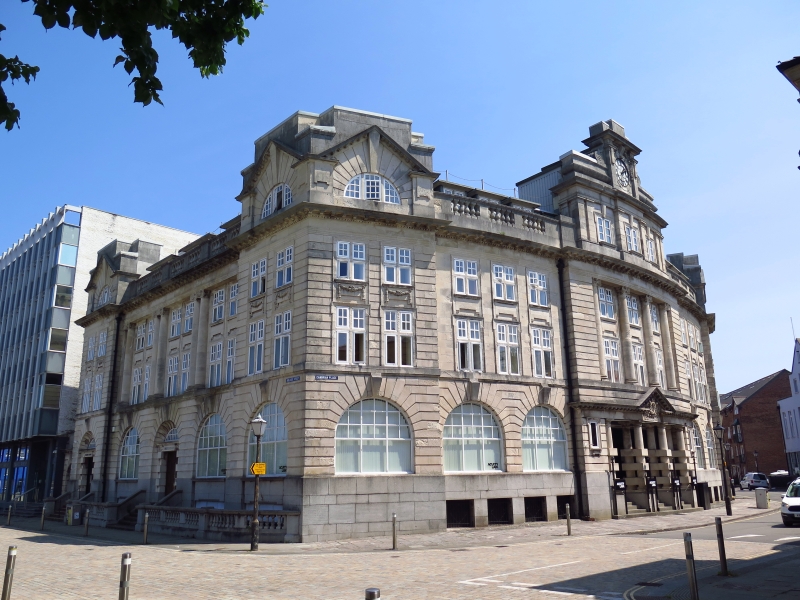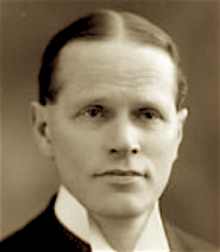Countess of Huntingdon Chapel
 |
| Exchange Building |
Swansea Exchange Building was built 1913-14 by Henry
Billings and Sons to the design of Charles Tamlin Ruthen, architect. His work also included Carlton Cinema in
Oxford Street and of the Mond Buildings in Union Street. The Exchange Building
main facade is built of Aberdeen grey unpolished granite (lower portions) and
Portland stone, with reinforced concrete used in its foundation. The foundation
stone was laid by Sir Alfred Mond on Saturday 3rd May 1913. Interior
consisted of around 80 offices, a restaurant, banking and post office
premises, lavatories, and automatic passenger lifts to serve all floors.
The building cost an estimated £24,000 and occupies a prominent
corner site, between Adelaide Street and Cambrian Place, and opposite the Royal
Institution (Swansea Museum). This site was previously occupied by the Hotel de
Paris which opened c.1878.
 |
| Charles Tamlin Ruthen |
Charles Tamlin Ruthen was born in Westoe, South Shields,
County Durham, England on 22nd of October 1871. From 1886 to 1890, Ruthen, was articled to
Matthew Hall. He also attended Newcastle
School of Art. After working as an
assistant in South Shields Borough Surveyor's Office, and as Assistant Surveyor
to Swansea Corporation, he commenced independent practice as an architect in
Swansea, Wales in 1896.
Ruthen’s address was given as Bank Chambers, Heathfield
Street, Swansea, in 1912 and 1926; and 5 Northampton Gardens, Swansea, 1912 and
1914; and 44 Bedford Row, London in 1923 and 1926. He died on 22nd
of October 1926. His death was registered in Swansea.
Ruthen’s architectural works included 29-47 Dillwyn Road,
Sketty, Glamorgan, Wales (1905); 1-11 De le Beche Road, Sketty, Glamorgan,
Wales (1906); Pantygwydr Baptist Church, Brynmill, Swansea(1906-07); Mond
Buildings, Union Street, Swansea, Wales (1911); Carlton Cinema, Oxford Street, Swansea,
Wales (1913-14); and Exchange Buildings, Swansea, Wales (1913-14); conversion
of existing building into the Albert Hall Cinema, Cradock
Street, Swansea, Glamorgan, Wales (c.1922). Also, Hotel Cameron; Mond Buildings;
Pantygwydr Chapel; Swansea Exchange Buildings; Carlton Theatre and Restaurant;
Albert Hall; Pictorium; Nurses' Home, operating theatre, male and female
Imbecile blocks, etc., for the Swansea Board of Guardians; "Cambria Daily
Leader" buildings; and many other works in Swansea and district.
 |
| Countess of Huntingdon Chapel |
Also situated on this site was the Countess of Huntingdon Chapel,
which was built in 1782 to the design of architect William Jernagen. The chapel
was then enlarged in 1841 and modified again in 1877.
William Jernagen, whose work includes the Mumbles Lighthouse. Jernagen had been engaged by the Swansea’s
Harbour Trustees. Since 1739, there had
been a coal-burning light on Flatholm, however it was decided that there would
be wo coal braziers at Mumbles, to avoid any confusion with Flatholm, though
using an oil-lamp was also considered.
In 1791, the Harbour Act, empowered the Swansea’s Harbour
Trust, to construct a building to hold coal for lights to warn ships of the
headland, with its reefs and shoals, and allowed dues to be levied on shipping
to regroup the cost.
| Mumbles Lighthouse |
Plans had been drawn up and were prepared for a 50ft-high
tower, and building began in 1792, but the badly built tower collapsed that
October. Jernagen had been appointed,
whose work included Stouthall and Countess of Huntingdon Chapel, and later of
Sketty Park House and the Assembly Rooms.
But who was Countess of Huntingdon?
 |
| Selina Hastings, Countess of Huntingdon |
Selina Hastings, Countess of Huntingdon, was born 24th
of August 1707 at Astwell Castle, Northamptonshire, was the second
daughter of Washington Shirley, 2nd Earl Ferrers, and Mary Levinge. Aged 17, Selina married Theophilus Hastings,
9th Earl of Huntingdon, who lived at nearby Donington Hall.
She gave birth to seven children in the first ten years of
the marriage, four of whom died young; her husband died in 1746, while she
allegedly suffered from poor health. The family were interested in politics,
religion and the arts, and commissioned portraits from fashionable artists of
the day.
In 1739, Lady Huntington joined the first Methodist society
in Fetter Lane, London. Sometime after the death of her husband in 1746,
she threw in her lot with John Wesley and George Whitefield in
the work of the great revival. According to Schlenther, it was Wesley who first
attracted her to Methodism, noting a visit to his chapel in Donnington (Wood)
in East Shropshire, in which a rare exception to egalitarian principles was
made and she was offered a private pew. Whitefield became her personal
chaplain, and, with his assistance, following problems put in her path by the
Anglican clergy from whom she had preferred not to separate, she founded the
"Countess of Huntingdon's Connexion", a Calvinistic movement
within the Methodist church.
In 1748, the countess gave Whitefield a scarf as her
chaplain, and in that capacity, he preached in one of her London houses, in
Park Street, Westminster, to audiences that included Chesterfield, Walpole and Bolingbroke.
She held large dinner parties at which Whitefield preached to the gathered
dignitaries after they had eaten.
Moved to further the religious revival in a Calvinistic
manner compatible with Whitefield's work, she was responsible for founding 64
chapels and contributed to the funding of others, insisting they should all
subscribe to the doctrines of the Church of England and use only the Book
of Common Prayer. Amongst these were chapels at Brighton (1761), Bath (1765), Worcester (c. 1766), Tunbridge
Wells (1769), several in Wales, and a small number in London including
founding one adjacent to her London home at Spa Fields, Clerkenwell/Finsbury. This included the one built in Swansea.
On the Countess's death in 1791, the 64 chapels and the
college were bequeathed to four trustees. Amongst them were Dr Ford, as well as
Lady Anne Agnes Erskine, who was requested to occupy and reside in Lady
Huntingdon's house adjoining Spa Fields Chapel, and carry on all needful
correspondence (which was immense). She did this dutifully until her own death
in 1804 and burial at Bunhill Fields

Comments
Post a Comment